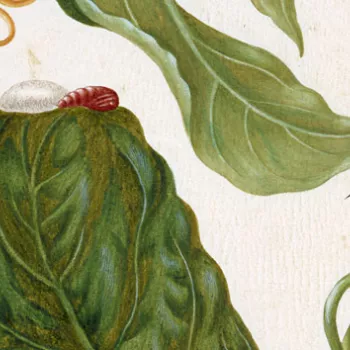The Pigeon of Passage and the Red Oak 1722-26
Watercolour and bodycolour heightened with gum arabic, over pen and brown ink | 26.9 x 36.3 cm (sheet of paper) | RCIN 924836
-
A watercolour of a passenger pigeon (Ectopistes migratoria (Linnaeus)), on a leaf of the turkey oak (Quercus laevis Walter). The whole is set against a landscape background. Inscribed in ink: (top left): Wood Pigeon Quercus Esculi divisara foliis amplioribus. Aculeatis. Pluk: Hist - Red Oak'; (bottom right) 'Quercus Esculi divisara foliis amplioribus aculeatis'; (top right) '23'. Inscribed ink ink on verso: 'A Virginia Wood Pidgeon comes in Winter Seazon'
Mark Catesby was born in Suffolk and was interested in natural history from an early age. In 1712, he travelled to the east coast of America with his sister Elizabeth, who had married a doctor who practised in Williamsburg, Virginia. Catesby spent seven years in Virginia collecting specimens and seeds for London buyers before returning to Britain. In London his drawings of birds and plants met with praise and a group of benefactors paid for his travel to Carolina in 1722. There, he made numerous drawings of the flora and fauna, working hard to ensure that his depictions were as helpful for an understanding of their subjects as possible. On his return to Britain, his drawings were reproduced in The Natural History of Carolina, Florida and the Bahama Islands, which appeared in a series of volumes between 1729 and 1747. The first volume was dedicated to Queen Caroline, the second to Augusta, Princess of Wales. The original drawings from the volumes, which had been in the possession of Catesby’s widow until her death, were purchased by George III from the London bookseller Thomas Cadell in 1768.
This watercolour was used as the basis for plate 23 in the first volume of the Natural History. In the published version, Catesby omitted the landscape. The passenger pigeon was once one of the most numerous of birds. Catesby recorded that they migrated to Virginia and Carolina in ‘incredible numbers’ and that people would shoot them down from their balconies and roof-tops. As the prairies of North America were diminished by settlements, the flocks declined dramatically. In 1914 the passenger pigeon became extinct when the last survivor of the species died in Cincinnati Zoo.
For identification of the species depicted see James L. Reveal, 'Identification of the plants and animals illustrated by Mark Catesby for his Natural History of Carolina, Florida, and the Bahama Islands' in Phytoneuron 2013 and revised online version.Provenance
Thomas Cadell; from whom bought by George III, 1768
-
Creator(s)
Acquirer(s)
-
Medium and techniques
Watercolour and bodycolour heightened with gum arabic, over pen and brown ink
Measurements
26.9 x 36.3 cm (sheet of paper)
Other number(s)
RL 24836Alternative title(s)
Palumbus Migratorius; Quercus Exculi divisura, foliis amplioribus aculeatis










